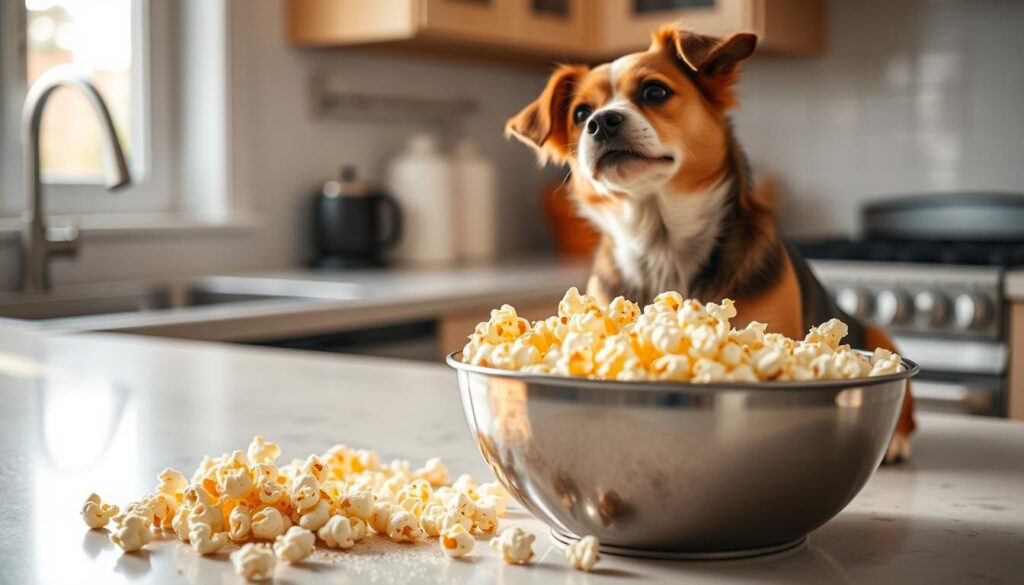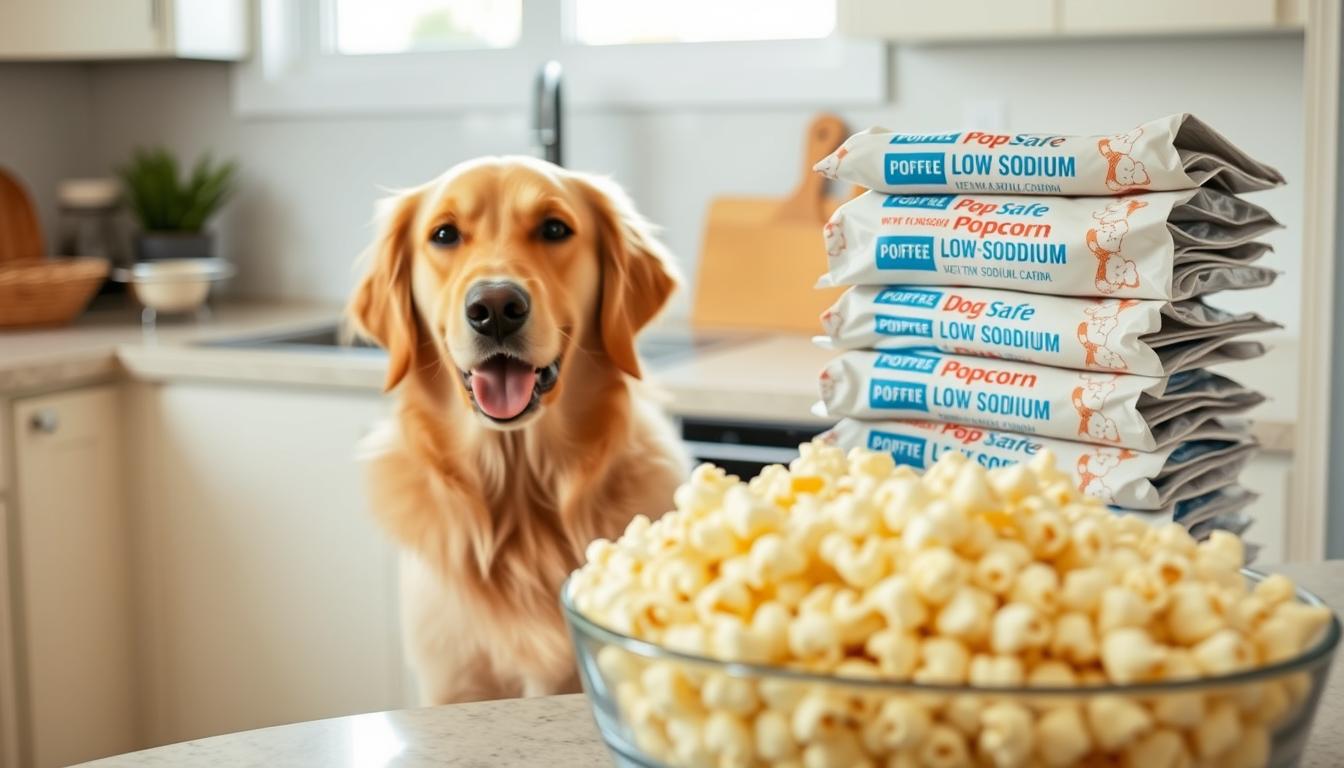Can Dogs Have Popcorn? Safety Tips and Guidelines
Table of Contents
As a dog owner, I’ve often wondered if I can share my favorite movie snack with my furry friend. The question “can dogs have popcorn” is more complex than you might think. It’s not a simple yes or no, but requires careful thought and knowledge.
Your dog might look at you with those irresistible puppy eyes when you’re eating popcorn. But not all popcorn is safe for dogs. Plain, air-popped popcorn can be a relatively safe treat when given in small amounts. It’s important to understand the safety of popcorn for dogs.
Before you share your snack, you’ll want to learn about the potential risks and benefits. Some popcorn preparations can be harmful, while others might offer little nutritional value. This guide will help you understand the world of popcorn and dogs. It will ensure you make informed decisions about your pet’s diet.
Key Takeaways
- Plain, air-popped popcorn can be safe for dogs in small quantities
- Avoid popcorn with salt, butter, or other additives
- Always monitor your dog when introducing new treats
- Popcorn should never replace balanced dog nutrition
- Consult your veterinarian about specific dietary concerns
Understanding Popcorn Safety for Dogs
Exploring popcorn safety for dogs is crucial for pet owners. They need to know if popcorn is safe for their furry friends. This involves looking at what popcorn is made of and its nutritional value.
Popcorn can be a safe treat for dogs if given in the right way. It has minerals that help meet your dog’s nutritional needs.
Basic Components of Popcorn
Plain, air-popped popcorn is mostly safe for dogs in small amounts. It’s made of:
- Whole grain kernels
- Minimal natural fiber
- Trace amounts of essential minerals
Nutritional Value for Dogs
Popped corn kernels have some good stuff for dogs, like:
- Magnesium: Helps muscles and nerves
- Phosphorous: Keeps bones strong
- Zinc: Boosts the immune system
- Small bits of dietary fiber
General Safety Considerations
Keeping popcorn safe for dogs involves a few important steps. Make sure the popcorn is:
- Plain and unseasoned
- Air-popped
- Free from butter, salt, or extra toppings
- Served in small amounts
Remember: Moderation is key when introducing any new food to your dog’s diet.
Even though popcorn is low in calories, it shouldn’t replace your dog’s regular food. Always talk to your vet before adding new treats to your dog’s diet.
The Benefits of Plain Air-Popped Popcorn
Thinking about giving air-popped popcorn to your dog? It’s a surprisingly healthy treat. Air-popped popcorn is good for your dog when given in small amounts and without extra stuff.
Using the air-popped method is best for popcorn for dogs. It gets rid of extra oils and additives. This makes it a low-calorie snack that can be a good addition to your dog’s diet.
- Low in calories and fat
- Natural source of dietary fiber
- Provides mental stimulation during training
- Free from harmful additives
Here are some key nutrients in air-popped popcorn for dogs:
| Nutrient | Benefit for Dogs |
|---|---|
| Fiber | Supports digestive health |
| Minerals | Provides trace amounts of magnesium and zinc |
| Antioxidants | Helps combat cellular damage |
Remember, air-popped popcorn should be an occasional treat, not a main part of their diet. Give small amounts without salt, butter, or seasonings to keep your dog safe and healthy.
Pro tip: Introduce popcorn slowly and watch for any adverse reactions in your dog.
Can Dogs Have Popcorn: A Comprehensive Guide
It’s tempting to share snacks with your furry friend. But, it’s important to know how to give popcorn safely. Popcorn can be a fun treat for dogs if given in small amounts.
Safe Serving Sizes for Dogs
Portion control is crucial when giving popcorn to dogs. The right amount depends on their size and weight. Here’s a guide:
- Small dogs: 1-2 tablespoons of plain, air-popped popcorn
- Medium dogs: 1/4 to 1/2 cup of plain, air-popped popcorn
- Large dogs: Up to 1 cup of plain, air-popped popcorn
Frequency of Popcorn Treats
Treats should not make up more than 10% of your dog’s daily calories. Popcorn should be an occasional treat, not a regular part of their diet. Give popcorn no more than 1-2 times a week.
Recognizing Popcorn Intolerance
Look out for these signs if your dog doesn’t like popcorn:
- Upset stomach
- Vomiting
- Diarrhea
- Excessive gas
- Lack of appetite
Always consult with your veterinarian before introducing new treats to your dog’s diet.
Remember, plain, air-popped popcorn is the safest choice for dogs. It should be without salt, butter, or other additives. Watch your dog’s reaction when they try it for the first time.
Dangerous Popcorn Toppings and Additives

Many popcorn toppings seem harmless but can be harmful to dogs. Your dog might look at you with those irresistible eyes. But not all popcorn seasonings are safe for them.
Some of the most dangerous popcorn toppings for dogs include:
- Butter and oil-based seasonings
- Salt and sodium-rich toppings
- Artificial flavors and chemical seasonings
- Garlic and onion powders
Ingredients in unsafe popcorn can cause serious health problems. Butter and oils can lead to pancreatitis, a painful inflammation of the pancreas. High salt content may result in sodium poisoning, which can cause dangerous electrolyte imbalances.
“The safest popcorn for your dog is plain, air-popped, and completely unseasoned.” – Veterinary Nutrition Experts
Artificial flavors and chemical additives can trigger digestive issues, allergic reactions, and potentially long-term health complications. Garlic and onion powders are particularly toxic and can damage your dog’s red blood cells.
Your best approach is to stick with plain, air-popped popcorn without any additional toppings. If you want to treat your dog, remove all seasonings and offer only a few plain kernels as an occasional snack.
Health Risks and Potential Hazards
Feeding popcorn to dogs can be risky. It might seem like a harmless snack, but it can harm your pet. Knowing the risks is key to keeping your dog safe and healthy.
Choking Hazards
Unpopped kernels are a big choking risk for dogs. They can get stuck in your dog’s throat or between their teeth. Small dogs are especially at risk.
- Whole kernels can block airways
- Partially popped corn has sharp edges
- Small dogs face higher choking risks
Digestive Issues
Dogs can have allergies or sensitivities to popcorn. Eating too much can upset their stomach, cause diarrhea, or constipation. Some dogs might also get intestinal discomfort.
- Potential stomach irritation
- Risk of intestinal blockage
- Possible allergic responses
Allergic Reactions
Some dogs can be allergic to corn-based products. Symptoms can be mild or severe, like skin issues, digestive problems, or breathing issues. Watch your dog closely after trying new foods.
- Watch for skin rashes
- Check for breathing difficulties
- Observe behavioral changes
Always talk to your vet before giving your dog new treats. This is especially true if you think they might have allergies or sensitivities.
Safe Preparation Methods for Dog-Friendly Popcorn
Preparing popcorn for dogs needs careful steps. Air-popping is the top choice. It makes a healthy and safe snack for your pet.

- Use a plain air popper without oil or additional seasonings
- Ensure kernels are fully popped to prevent choking hazards
- Allow popcorn to cool completely before serving
- Remove any unpopped or partially popped kernels
The best way to make dog-safe popcorn is simple. Plain, air-popped kernels are the safest option for your dog.
| Preparation Method | Dog Safety Rating |
|---|---|
| Air-Popped Popcorn | Safest Option |
| Microwave Popcorn | Not Recommended |
| Stovetop Popcorn | High Risk |
“Clean, simple popcorn is the key to a safe treat for your dog.” – Veterinary Nutrition Experts
If you want to add flavor, consider these dog-friendly options:
- A tiny amount of unsweetened peanut butter
- A small portion of pureed pumpkin
- Plain, unseasoned popcorn
Remember, moderation is key when giving popcorn to dogs. Start with small amounts and watch for any adverse reactions.
Signs Your Dog Has Eaten Too Much Popcorn
It’s worrying when you find out your dog ate too much popcorn. Popcorn poisoning in dogs is a real risk. Knowing the signs can help keep your pet safe.
Dogs can show different symptoms after eating too much popcorn. These signs can mean they’re not feeling well. Spotting them early is key to avoiding bigger problems.
Physical Symptoms to Watch For
- Digestive Distress: Vomiting or diarrhea
- Unusual lethargy or weakness
- Excessive thirst or changes in drinking habits
- Abdominal pain or discomfort
- Loss of appetite
When to Contact Your Veterinarian
Some symptoms need vet help right away. If your dog shows severe or lasting reactions after eating popcorn, call your vet fast.
| Symptom Severity | Recommended Action |
|---|---|
| Mild Symptoms | Monitor closely, ensure hydration |
| Moderate Symptoms | Call veterinarian for advice |
| Severe Symptoms | Seek immediate veterinary care |
Popcorn poisoning in dogs can show in many ways. Be ready to tell your vet about the popcorn, how much, and how your dog reacted. Acting quickly can stop bigger health problems.
Alternative Healthy Snacks for Dogs
Looking for popcorn alternatives for dogs? You have many healthy options. These treats are fun and good for your dog’s health.
Fresh fruits and veggies are great choices. They’re low in calories but full of nutrients. They can keep your dog happy and healthy.
- Carrots: Crunchy and low-calorie
- Apple slices: Rich in vitamins (remove seeds)
- Cucumber: Hydrating and low-calorie
- Blueberries: Packed with antioxidants
- Green beans: Nutritious and filling
There are also commercial treats made just for dogs. They help keep teeth clean and provide balanced nutrition.
| Treat Type | Nutritional Benefit | Serving Size |
|---|---|---|
| Dental Chews | Supports oral health | 1-2 per day |
| Freeze-Dried Meat Treats | High protein | Small pieces |
| Pumpkin Treats | Digestive support | Small handful |
Remember to introduce any new treats gradually and in moderation. Always check with your vet to make sure they’re right for your dog.
Pro tip: Homemade treats can be a great way to control ingredients and provide nutritious snacks for your canine companion.
Special Considerations for Different Dog Breeds
Dogs come in all shapes and sizes, and so do their popcorn needs. The size and breed of your dog are key to figuring out how much popcorn is safe.
Small dogs need extra care with popcorn. Their tiny stomachs and small bodies mean they can only have a few kernels. It’s important to keep portions small for these dogs.
- Toy breeds: Limit to 2-3 plain kernels
- Small breeds: Maximum of 5-6 kernels
- Medium breeds: Up to half a cup of air-popped popcorn
- Large breed dogs: Can handle up to one cup of plain popcorn
Big dogs can usually handle a bit more popcorn. But remember, they shouldn’t snack all day. Keep an eye on how they react to popcorn and watch for any signs of upset stomach.
| Dog Size | Recommended Popcorn Portion | Frequency |
|---|---|---|
| Toy Breeds | 2-3 kernels | Occasional treat |
| Small Breeds | 5-6 kernels | Rare treat |
| Medium Breeds | 1/2 cup | Infrequent treat |
| Large Breed Dogs | Up to 1 cup | Occasional treat |
Some dogs might not be good candidates for popcorn. Dogs with sensitive stomachs or at risk for obesity should avoid it. Always talk to your vet before adding new treats to your dog’s diet.
Conclusion
Understanding the guidelines for dogs and popcorn is key. Plain, air-popped popcorn can be a safe treat for dogs sometimes. But, it should never be a main part of their diet.
Feeding popcorn to dogs safely is important. Give them small, plain portions without butter, salt, or extra flavors. Watch how they react and how much they eat, keeping treats a small part of their diet.
Dogs have different needs, so it’s best to check with your vet. They can tell you if popcorn is okay for your dog based on their health, breed, and sensitivities.
Being careful and informed is part of being a good pet owner. Popcorn can be a fun treat for dogs if given correctly. But, it should never be a regular part of their diet.
There are no reviews yet. Be the first one to write one.


